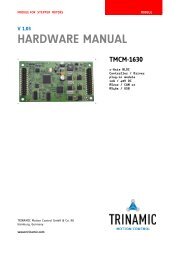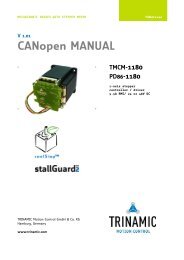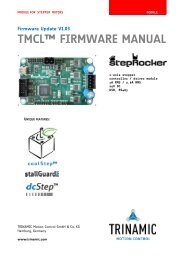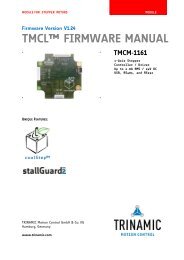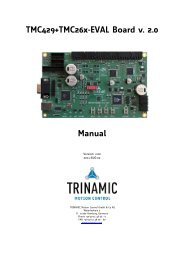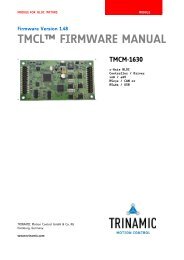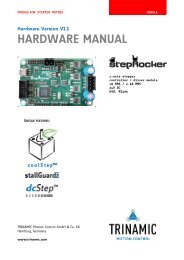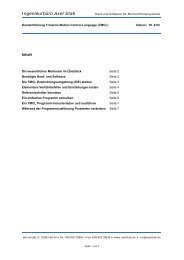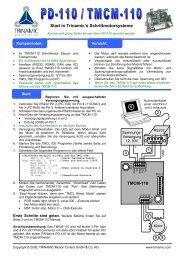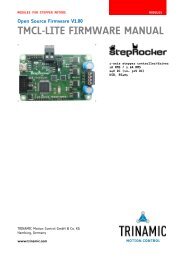TMC428 – Application Note - Trinamic
TMC428 – Application Note - Trinamic
TMC428 – Application Note - Trinamic
Create successful ePaper yourself
Turn your PDF publications into a flip-book with our unique Google optimized e-Paper software.
<strong>TMC428</strong> <strong>–</strong> <strong>Application</strong> <strong>Note</strong> <strong>–</strong> <strong>TMC428</strong> Getting Started <strong>–</strong> Including StallGuard TM 4<br />
(v. 2.00 / April 14, 2008)<br />
For this sample configuration, the fast decay control bits of <strong>TMC428</strong> are mapped as fixed Zero for the<br />
driver #1, fixed One for the driver #2 of the chain. For driver # 3 the FD_A is mapped to MDA and<br />
FD_B is mapped to MDB. Please refer the TRINAMIC stepper motor driver datasheets (TMC236 /<br />
TMC239 / TMC246 / TMC249) concerning the mixed decay feature. In plain text, it is<br />
Zero, A_5, A_4, A_3, A_2, PH_A, Zero, B_5, B_4, B_3, B_2, PH_B, One, A_5, A_4, A_3,<br />
A_2, PH_A, One, B_5, B_4, B_3, B_2, PH_B, FD_A, A_5, A_4, A_3, A_2, PH_A FD_B, B_5,<br />
B_4, B_3, B_2, PH_B, One, One, One, One, One, One, One, One, One, One, One, One,<br />
One, One, One, One, One, One, One, One, One, One, One, One, One, One, One, One,<br />
0, 2, 3, 5, 6, 8, 9, 11, 12, 14, 16, 17, 19, 20, 22, 23,<br />
24, 26, 27, 29, 30, 32, 33, 34, 36, 37, 38, 39, 41, 42, 43, 44,<br />
45, 46, 47, 48, 49, 50, 51, 52, 53, 54, 55, 56, 56, 57, 58, 59,<br />
59, 60, 60, 61, 61, 62, 62, 62, 63, 63, 63, 63, 63, 63, 63, 63<br />
Please keep in mind that the DAC MSBs of the <strong>TMC428</strong> are DAC_A_5 resp. DAC_B_5, where the<br />
DAC MSBs of the TMC236 / TMC239 / TMC246 / TMC249 drivers are CA3 resp. CB3. So, DAC_A_5<br />
is mapped to CB3 resp. DAC_B_5 is mapped to CB3, and the other DAC bits are mapped accordingly.<br />
Once initialized, the configuration of the stepper motor driver chain is left unchanged in most cases<br />
during normal operation. In some cases, the fast decay control has to be changed. Please take into<br />
account that a write access to a RAM always overwrites a pair of <strong>TMC428</strong> RAM values. A read access<br />
to the RAM always reads out a pair of values. Combining RAM read and RAM write allows the<br />
modification of a single value.<br />
Use of the sensorless stall detection StallGuard (TMC246 / TMC249) requires the mixed decay feature<br />
to be switched off. At high speed, stepper motors might run better when the fast decay feature is<br />
permanently switched on. Some motors run best when mixed decay is switched on only during phases<br />
of decreasing current. The configuration can be modified also during operation by re-programming the<br />
stepper motor driver chain configuration.<br />
The quarter sine wave look-up table RAM area is left unchanged for almost any application after it has<br />
been initialized. Changes might be wanted for fine tuning of micro stepping or for temporary changing<br />
from micro stepping to full stepping at high speed or to use a trapezoidal current shape that is more<br />
compatible with StallGuard than full stepping. Sine wave micro stepping is the best choise for most<br />
applications. Additionally, one has to take into account that changes of the quarter sine wave look-up<br />
table commonly apply to all stepper motors.<br />
SDI_S<br />
SCK_S<br />
SDO_S<br />
nSCS_S<br />
CSN<br />
SCK<br />
SDI<br />
shift register<br />
parallel register<br />
0 1 2 3 4 5 6 7 8 9 10 11<br />
PHB<br />
CB0<br />
CB1<br />
CB2<br />
CB3<br />
MDB<br />
PHA<br />
CA0<br />
CA1<br />
CA2<br />
CA3<br />
MDA<br />
control signals<br />
Driver # 3<br />
TMC236 / TMC239 / TMC246 / TMC249<br />
Copyright © 2005-2008 TRINAMIC Motion Control GmbH & Co. KG<br />
SDO<br />
CSN<br />
SCK<br />
SDI<br />
shift register<br />
parallel register<br />
0 1 2 3 4 5 6 7 8 9 10 11<br />
PHB<br />
CB0<br />
CB1<br />
CB2<br />
CB3<br />
MDB<br />
PHA<br />
CA0<br />
CA1<br />
CA2<br />
CA3<br />
MDA<br />
control signals<br />
Driver # 2<br />
TMC236 / TMC239 / TMC246 / TMC249<br />
SDO<br />
CSN<br />
SCK<br />
SDI<br />
shift register<br />
parallel register<br />
0 1 2 3 4 5 6 7 8 9 10 11<br />
PHB<br />
CB0<br />
CB1<br />
CB2<br />
CB3<br />
MDB<br />
PHA<br />
CA0<br />
CA1<br />
CA2<br />
CA3<br />
MDA<br />
control signals<br />
Driver # 1<br />
TMC236 / TMC239 / TMC246 / TMC249<br />
Figure 1 : SPI Chain Outline <strong>–</strong> Serial Transmitted Control Bits vs. Parallel Control Signals<br />
All SPI datagram bits are shifted through the driver chain (Figure 1) with the SPI clock SCK_C. The<br />
actual content of the shift register chain is loaded into parallel buffer registers with the rising edge of<br />
the SPI enable signal nSCS_S. A set next motor bit forces the <strong>TMC428</strong> to select internally the control<br />
bits for the next motor. The next motor bit is not transmitted via the SPI driver chain. The different<br />
drivers are addressed by their position within the chain.<br />
SDO



